Contents


Before the widespread use of potatoes, the number one vegetable was peas. It was cultivated on a par with the main crops, eaten as often as they were, that is, bread and peas occupied the main place on the table. The old name for pea jelly (who cooks it today?) is “sat”. It reflects the composition of the seeds of a modest herbaceous plant called peas, rich in proteins, sugars, vitamins. Now summer residents are trying to sow the best varieties of peas in order to eat delicious peas throughout the summer.
Description of the plant
Peas are an annual herbaceous plant belonging to the legume family. Its root is tap-type, but very branched. Like other plants of this family, with its roots it improves the soil, enriches it with nitrogen. This is due to nodule bacteria that develop among its roots. They absorb nitrogen from the atmosphere and store it in the soil. That is why different varieties of peas are advised to be sown before planting the main plants, that is, they are often used as green manure.
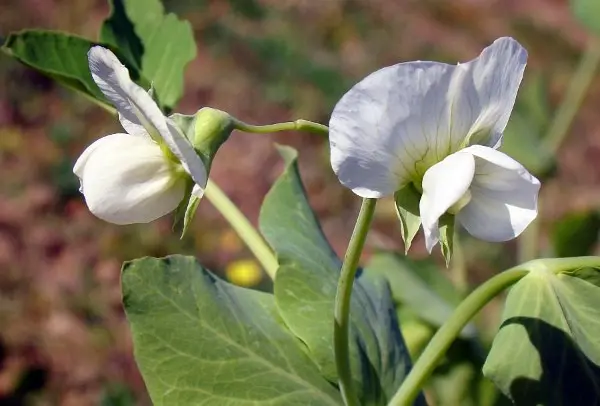
The stem of the plant is hollow herbaceous. It can be lodging or bushy, simple or branching, depending on which species and varieties are selected. Different varieties of peas differ in stems of different lengths, they can be from 15 cm to 2,5 m long. The leaves are pinnate, the terminal leaves have changed, turning into antennae that help curl. As you know, the plant clings to the support with them.
Different varieties differ in color (light green, dark green, even bluish). Shape and size are also different. Bisexual flowers of moth type are white or purple in different shades.
The fruit is a bean according to the pedigree, although we call it a pod.
Each bean contains 4 to 10 seeds. They also differ in color and shape. The seeds that we call peas are round or irregularly angular, smooth or wrinkled.
The amazing nutritional value of the vegetable is due to the huge content of vegetable protein in it with a number of essential amino acids. In addition, it contains various sugars, starch, vitamins, fiber, salts of potassium, calcium, phosphorus, and iron. Folk medicine uses decoctions of the seeds and leaves of this amazing plant as a diuretic, and pea flour is used as a poultice to soften boils.
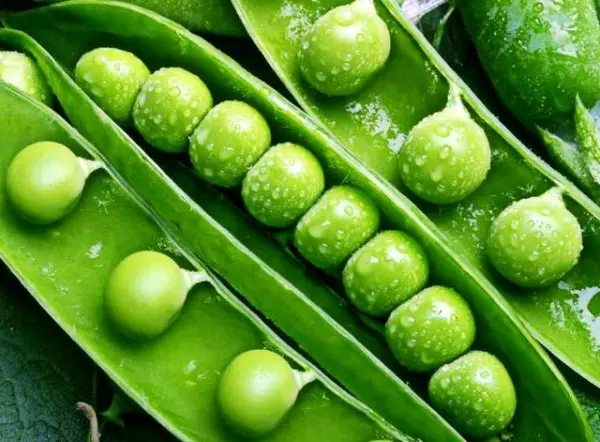
Classification
The botanical classification divides the entire genus of peas into the following types: red-yellow and sowing. Red-yellow is only wild, it is not cultivated. It grows in Asia Minor. The plant is undersized. Its stem is thin, the fruits are small (no more than 4 cm), light green, the seeds are round, their diameter is not more than 0,4 cm.
Sowing peas, in turn, are divided into 6 subspecies:
- tall;
- Syrian;
- Abyssinian;
- transcaucasian;
- Asiatic;
- sowing.
The first two subspecies are simply weeds, the next three are cultivated, but quite primitively. Only sowing peas are widely grown as a food, fodder, and green manure crop. Here are the varieties of peas that have a great nutritional value. It is among them that there are sugar, sweet, brain varieties, descriptions and characteristics of which summer residents are looking for, the seeds of which are sown on their plots.
A huge number of varieties of sowing peas are divided into two large groups according to the structure of their fruit – peeling and sugar.
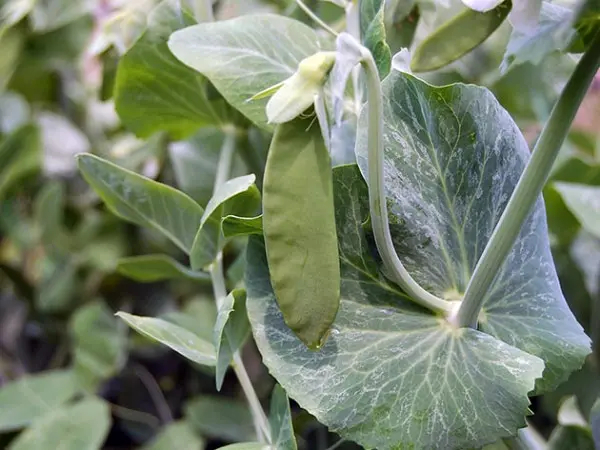
Shelling pea pods have a hard parchment layer, they are not eaten even in green unripe form. Mature seeds contain a lot of starch, they are dried, frozen, canned, they are perfectly boiled soft, used to make soups and cereals.
Sugar pea pods do not have such a parchment layer, they are sweet and tender, so unripe fruits are eaten whole. Ripe fruits do not look so beautiful, wrinkle slightly, because in the process of ripeness they lose moisture. Sugar peas are more capricious in terms of soil and care, they get sick more often, they are attacked by pests.
Brain called those varieties in which the seeds are not smooth, but wrinkled, square in shape. They have little starch, but a lot of sucrose, they are sweeter in taste, do not boil soft when cooked. Smooth round and wrinkled square seeds are found in both shelling and sugar varieties. Sweet peas, or rather their seeds, are eaten unripe, canned and frozen.
Top Grades
Sowing peas are divided into varieties depending on different characteristics. So all its varieties are divided into table, canning and universal. Canteens are usually used for preparing various dishes in a ripened state. Canned food is eaten and harvested at the stage of green peas. Universal are used both unripe and fully ripe.
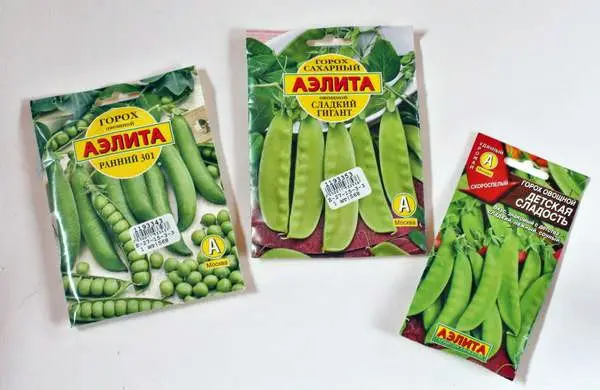
All varieties are divided into 3 large groups depending on the length of the growing season. The early ones mature in 45–60 days, the medium ones in 60 to 80 days, and the late ones need more than 80 days after germination to ripen completely.
When choosing a variety for cultivation, you need to carefully read the description, paying attention to the ripening time, description of the taste and purpose of the fruit.
“Avola”
This is a medium-early hulling variety, it only takes 57 days for it to mature. “Avola” is consumed fresh, frozen and canned. It grows up to 70 cm, does not require support, forms bright green fruits with sweet fleshy peas.
“Adagumsky”
This is also a mid-season pea, ripening in 55 days. The plant produces dark green fruits up to 8 cm long with 5–9 sweet brain seeds (peas). It grows up to 60 cm without support. The seeds are eaten and used in cooking, canned and frozen for long-term storage.
“Alpha”
In the early shelling peas “Alpha”, technical ripeness occurs 46–53 days after germination. This undersized plant forms wide (up to 1,5 cm) and long (up to 9 cm) fruits, each of which contains from 5 to 9 peas. It is most often canned, but it is also good fresh.

“Viola”
The mid-season peeling variety “Viola” ripens 61-79 days, the stem grows up to 80 cm, the fruit is green, slightly curved, its seeds are squeezed-square, they are used as green peas, canned. “Viola” grows well in the non-chernozem zone.
“Troika”
Late shelling peas “Troika” ripen in 80-90 days, it belongs to medium-sized universal brain varieties.
“Hava pearl”
Mid-season shelling peas ripen in 60-70 days, they are universal, they are consumed fresh and canned. It grows from 70 to 100 cm, forms curved pointed dark green beans up to 8 m long.
«Zhegalova 112»
Mid-season sugar, ripens 60–80 days after germination. Its brain sweet seeds (8-10 pieces) are placed in a wide long light green pod. The stem grows up to 180 cm. It is eaten and canned both unripe and fully ripe.
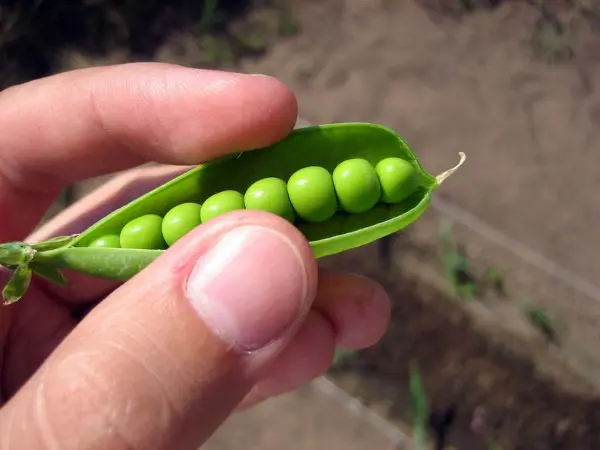
“Inexhaustible 195”
This wonderful sugar variety is mid-season, it ripens in 65 days. It can give a second crop if the first one is not allowed to overripe on the stem. The stem grows up to 115 cm, the fruits are light green, large, up to 10 cm long, their wings are thick and sweet. Peas are eaten fresh, canned and frozen.
“Oregon”
It is also called “Sugar 2”, it is medium-early ripening sugar peas (55-60 days), the seeds are eaten fresh, frozen and canned. The plant grows up to 120 cm, the pods are long with thick fleshy valves without a parchment layer.
“Gregor”
High-yielding mid-season peas, which are grown in Ukraine on large areas. Gregor seeds are high in protein. The stem grows up to 110 cm, resistant to lodging.
Early ripe varieties “Madonna” and “Starter” with similar characteristics are called new generation peas. They are not capricious, undemanding to agricultural technology, show excellent resistance under adverse weather conditions.
Video “Peas of different varieties on the site”
Look at a short review about the features of growing vegetable peas, in particular varieties of Alpha, Grasshopper, Sweet Pearl.









